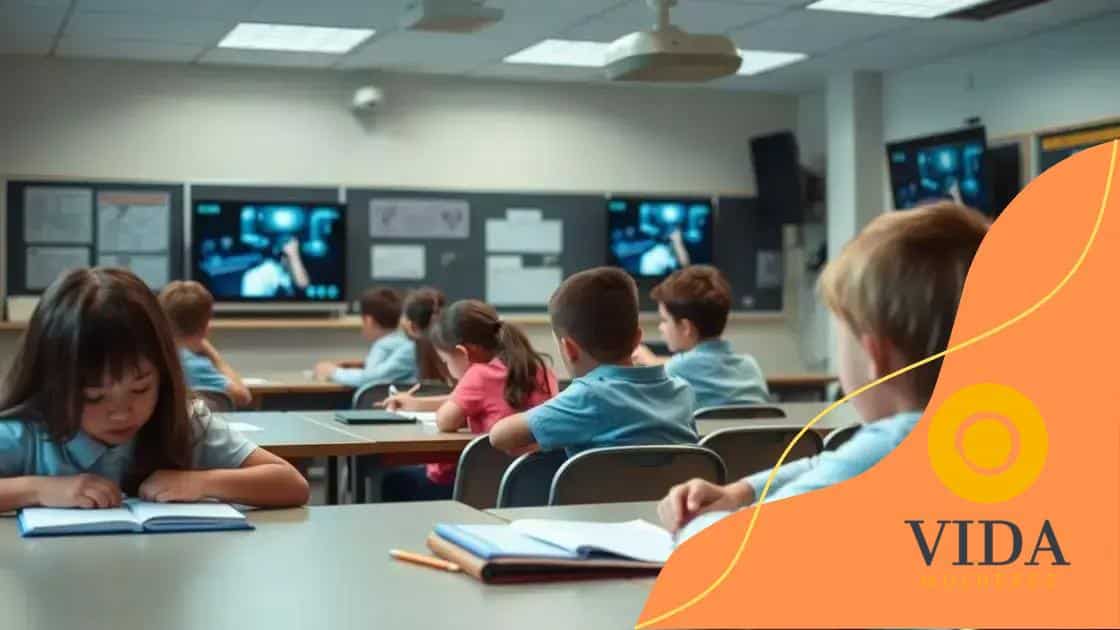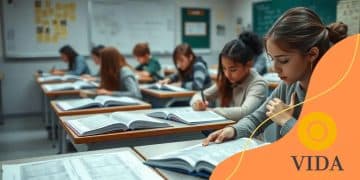Teacher surveillance tools raise privacy concerns

Teacher surveillance tools raise privacy concerns by potentially infringing on students’ rights and creating a climate of mistrust, necessitating a balance between ensuring safety and preserving individual privacy.
Teacher surveillance tools raise privacy concerns that challenge the boundaries of trust in education. As educators seek to maintain a safe learning environment, how do these technologies affect student autonomy and privacy? Let’s explore this complex issue.
Overview of teacher surveillance tools
The world of education is evolving, and so are the tools that teachers use to oversee their classrooms. Teacher surveillance tools have gained traction in recent years, aimed at ensuring a safe learning environment. However, understanding these tools is crucial for educators and students alike.
Types of Teacher Surveillance Tools
Different types of surveillance tools exist, each serving unique purposes. Some tools aim to monitor student behavior, while others focus on academic performance. Here are a few common types:
- Video monitoring systems
- Screen monitoring software
- Attendance tracking technologies
- Behavioral tracking apps
These tools are often implemented to enhance student safety and optimize classroom management. For instance, video monitoring systems have become popular in many schools. They provide real-time feeds that help teachers keep an eye on interactions among students.
Purpose and Benefits
The primary goal of employing teacher surveillance tools is to create a secure educational environment. When students feel safe, they can focus better on learning. Moreover, these tools help in identifying problems early, which can lead to timely interventions.
However, it’s essential to assess whether such tools impact the learning experience positively or negatively. Continuous surveillance may inadvertently make students feel uncomfortable or distrusted. Thus, schools must strike a balance between safety and fostering a trusting atmosphere.
Integrating these tools effectively requires clear communication with students and parents. Teaching kids about the reasons behind surveillance can help mitigate concerns. Educators should emphasize that these tools are in place to assist, not to invade privacy.
Whether it’s for enhancing student safety or managing classroom dynamics, understanding teacher surveillance tools is vital. Continuous dialogue about their usage ensures that they are beneficial and appropriate within the educational context.
Impact on student privacy

The use of teacher surveillance tools raises significant questions about student privacy. As schools implement these technologies, it is vital to consider how this impacts the personal space of students. Surveillance practices can make students feel like they are constantly watched, which can have a lasting effect on their behavior and trust.
Privacy Concerns
One major concern is that continuous monitoring might invade a student’s privacy. When students know they are being watched, it can lead to anxiety and inhibit their willingness to express themselves. They may worry about how their actions are perceived, which can alter their behavior.
Effects on Student Behavior
Such surveillance can affect classroom dynamics. Students might feel less inclined to participate in discussions, fearing that their opinions will be scrutinized. This lack of genuine expression can lead to a stifled learning environment. Here are some effects on student behavior:
- Increased anxiety about being judged
- Less open communication with teachers
- Reduced engagement in classroom activities
- Decreased trust between students and educators
Furthermore, the emotional impact of being surveilled can create a culture of mistrust among students and teachers. If students feel their privacy is violated, they may pull away from faculty and peers. Trust is crucial for effective learning and student growth.
On the other hand, it is important to acknowledge that some level of monitoring can enhance safety. While safety is critical, schools must balance this with the need for student privacy. Engaging students in conversations about the purpose and extent of monitoring can help mitigate some concerns.
Ultimately, the impact on student privacy is complex. Schools must strive to create an environment that fosters both safety and trust, ensuring that students feel secure while respecting their personal space.
Ethical implications of monitoring
The use of teacher surveillance tools comes with serious ethical implications that cannot be overlooked. When schools decide to monitor student behavior, they must carefully consider the moral responsibilities involved in such decisions. The main ethical concerns revolve around privacy, consent, and the potential for misuse.
Privacy Matters
Respecting student privacy is a foundational principle in education. Surveillance may infringe on students’ rights to a private learning environment. When they feel their actions are constantly scrutinized, it can lead to a lack of trust and openness. Here are key points to consider:
- Constant monitoring can produce stress and anxiety.
- It may create a culture of fear among students.
- Students deserve to feel safe and respected while learning.
Moreover, schools must reflect on how data collected from surveillance tools is used. If schools store or share this information without proper governance, it could lead to unethical practices that compromise student integrity.
Consent and Transparency
Obtaining consent is another ethical aspect. Students and parents should be made aware of what monitoring entails. Transparent communication about the purpose and scope of surveillance is essential. When stakeholders know how the data will be used, it helps foster an atmosphere of trust.
Furthermore, discussions about the implications of these tools can empower students. When they understand their rights and the reasons behind monitoring, they are more likely to see it as a supportive measure rather than an invasion of privacy.
It’s also important to consider the role of teacher training in this context. Educators should be equipped with knowledge about ethical guidelines and how to maintain privacy while ensuring safety. This creates a balanced approach that respects students while also fulfilling the responsibility of creating a safe educational environment.
In the end, as surveillance tools become more prevalent in schools, ethical considerations must stay at the forefront. A thoughtful approach to monitoring not only protects students but also builds a stronger educational community.
Balancing security and trust
Balancing security and trust in education is a delicate task. With the introduction of teacher surveillance tools, schools must ensure they provide a safe environment while maintaining students’ trust. The challenge lies in implementing safety measures without causing students to feel like they are under constant scrutiny.
Importance of Trust
Trust plays a vital role in the student-teacher relationship. When students trust their teachers, they are more likely to engage in learning and express their ideas openly. If surveillance tools make students feel uneasy or mistrustful, it can hinder their academic growth. Here are a few key aspects of maintaining trust:
- Open communication about monitoring practices.
- Encouraging student feedback on surveillance methods.
- Emphasizing the purpose of safety rather than control.
It is crucial for teachers to convey that the aim of these tools is to protect, not to invade privacy. By fostering open dialogues, educators can reassure students about how surveillance contributes to their well-being.
Implementing Security Measures
Effective security measures can enhance the learning environment. However, it is essential that schools implement them thoughtfully. Solutions such as screen monitoring or video surveillance should be used transparently. When schools demonstrate they use these tools responsibly, students are more likely to feel secure rather than fearful.
Schools can find a middle ground by setting clear boundaries on surveillance. For instance, monitoring should focus on specific risks rather than encompassing every aspect of student behavior. This targeted approach helps in maintaining a balance between security and privacy.
Educators should also receive training on how to utilize these tools ethically. Understanding the importance of confidentiality and the impact of surveillance on student relationships is crucial. The goal is to create a safe learning atmosphere that respects individual privacy while ensuring safety.
Ultimately, finding the right balance between security and trust requires continuous effort and communication. Schools must adapt and evolve their monitoring practices to reflect the needs and concerns of their students, fostering an environment where both safety and trust coexist.
Future of surveillance in education
The future of surveillance in education is evolving rapidly due to advancements in technology. As schools look for ways to enhance safety and improve learning environments, new surveillance tools are emerging. Understanding these developments is crucial for students, parents, and educators alike.
Emerging Technologies
New technologies are reshaping how surveillance is implemented in schools. For example, artificial intelligence (AI) can analyze student interactions and flag any concerning behavior. This can lead to timely interventions, ensuring the well-being of students. Here are some technologies shaping the future of surveillance:
- AI-based monitoring systems that analyze classroom dynamics.
- Wearable devices for real-time health and safety monitoring.
- Enhanced video analytics for identifying specific behaviors.
- Mobile applications that track student engagement.
These innovations promise increased safety and support for students, but they also raise important questions about privacy and ethics.
Balancing Innovation and Ethics
While these advancements offer significant benefits, they must be implemented with caution. The balance between safety and privacy remains a pressing issue. As technology evolves, schools must evaluate how much monitoring is necessary and how to protect student information. Strong policies and clear guidelines are essential for maintaining this balance.
Schools should engage students and parents in discussions about how surveillance tools will be used. Open dialogues about privacy concerns can foster trust and understanding. To create a supportive environment, schools need to clarify the purpose and limitations of surveillance technology.
Moreover, ongoing training for educators on the ethical use of surveillance tools is vital. When teachers understand the implications of monitoring technologies, they can use them responsibly while maintaining a positive learning atmosphere.
In summary, the future of surveillance in education offers exciting possibilities but requires careful navigation of ethical considerations. By embracing new technologies thoughtfully, schools can create safer, more engaging learning environments for all students.
FAQ – Teacher Surveillance Tools and Privacy Concerns
What are teacher surveillance tools?
Teacher surveillance tools are technologies used in classrooms to monitor student behavior and maintain safety, such as video cameras and screen monitoring software.
How do surveillance tools impact student privacy?
Surveillance tools can raise privacy concerns by making students feel like they are being constantly monitored, which may affect their comfort and willingness to participate.
What ethical considerations are involved with surveillance in education?
Ethical considerations include obtaining consent, respecting students’ privacy rights, and ensuring that the implementation of these tools does not stifle trust and open communication.
How can schools balance security and student trust?
Schools can balance security and trust by maintaining open dialogues with students and parents about monitoring practices, emphasizing safety over control, and implementing clear policies.






